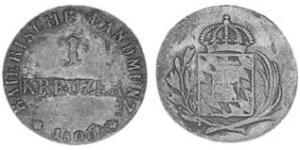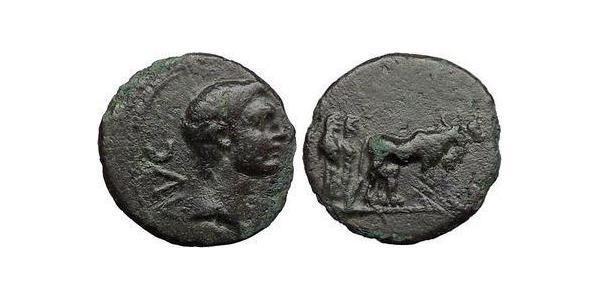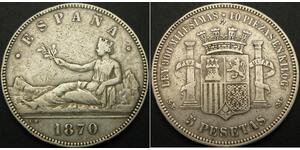[ 4592] AUGUSTUS 27 B.C. - 14 A.D. Bronze (19mm, 2.75 gm.) Macedonia: Phillipi, 14-27 A.D. Reference: RPC 1656. AVG. Bare head of Augustus right. Two priests side by side staggered with plow and oxen. Provided with certificate of authenticity. CERTIFIED AUTHENTIC by Sergey Nechayev, PhD - Numismatic Expert Philippi (in Greek Φίλιπποι/ Philippoi) was a city in eastern Macedonia, in northern ancient Greece, established by Philip II in 356 BC and abandoned in the 14th century after the Ottoman conquest. The present municipality Filippoi is located near the ruins of the ancient city and it is part of the periphery of East Macedonia in Greece. The city reappears in the sources during the Roman civil war that followed the assassination of Julius Caesar. His heirs Mark Antony and Octavian confronted the assassins of Caesar, Marcus Junius Brutus and Cassius, at the Battle of Philippi in the plain to the west of the city in October, 42 BC. Antony and Octavian were victorious in this final battle against the partisans of the Republic. They released some of their veteran soldiers, probably from legion XXVIII and colonized them in the city, which was refounded as Colonia Victrix Philippensium. In 30 BC, Octavian became Roman emperor, reorganized the colony, and established more settlers there, veterans possibly from the Praetorian Guard and other Italians. The city was renamed Colonia Iulia Philippensis, and then Colonia Augusta Iulia Philippensis after January, 27 BC, when Octavian received the title Augustus from the Roman Senate. Following this second renaming, and perhaps after the first, the territory of Philippi was centuriated (divided into squares of land) and distributed to the colonists. The city kept its Macedonian walls, and its general plan was modified only partially by the construction of a forum, a little to the east of the site of Greek agora. It was a "miniature Rome," under the municipal law of Rome and governed by two military officers, the duumviri, who were appointed directly from Rome. Ruins of the centre of the city: the forum in the foreground, the market and the basilica in the background. The colony recognized its dependence on the mines that brought it its privileged position on the Via Egnatia. This wealth was shown by the many monuments that were particularly imposing considering the relatively small size of the urban area: the forum, laid out in two terraces on both sides of the main road, was constructed in several phases between the reigns of Claudius and Antoninus Pius, and the theatre was enlarged and expanded in order to hold Roman games. There is an abundance of Latin inscriptions testifying to the prosperity of the city. In AD 49 or 50, the city was visited by the apostle Paul who was guided there by a vision (Acts 16:9-10). Accompanied by Silas, Timothy and possibly Luke, the author of the Acts of the Apostles, he preached for the first time on European soil in Philippi (Acts 16:12-40) and baptized Lydia, a purple dye merchant, in a river to the west of the city. While in Philippi, his exorcism of a demon from a slave girl caused a great uproar in the city, which led to their (Paul and Silas) arrest and public beating (Acts 16:16-24). An earthquake caused their prison to be opened. When the jailer awoke, he prepared to kill himself, thinking all the prisoners had escaped and knowing that he would be severely punished. Paul stopped him, indicating that all the prisoners were in fact still there. The jailer then became one of the first Christians in Europe (Acts 16:25-40). At this time, there was barely a Jewish community and no synagogue (Acts 16:13). Those Jews present did not seem to include any men and met by the river, a common meeting place in the absence of a synagogue. Paul visited the city on two other occasions, in 56 and 57. The Epistle to the Philippians dates from around 61-62 and shows the immediate impact of Paul's instruction. The subsequent development of ...
Mehr...

|
Beigetragen von:
anonymous 2015-08-18 |
Similar Coin Groups

1 Kreuzer Königreich Bayern (1806 - 1918 ...
Diese Gruppe hat 2 Münzen / 1 Preise
Add coin to this group
2025-06-16
- New coin is added to 5 Peseta Erste Spanische Republik (1873 - 1874) Silber
5 Peseta Erste Spanische Republik (1873 - 1874) Silber
Diese Gruppe hat 38 Münzen / 33 Preise
⇑
SPAIN 5 Pesetas 1870 SNM - Silver .900 - VF - 594
2025-05-24
- New coin is added to 1 Liard Belgien Kupfer
1 Liard Belgien Kupfer
Diese Gruppe hat 4 Münzen / 4 Preise
⇑
Austrian Netherlands - Liard 1790 - Head
Das könnte Sie auch interessieren:













-300-150-DTwKX9ISLbYAAAFanYlMgKms.jpg)








